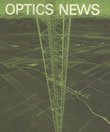
April, 1977 Issue
Feature Articles
The Boulder Atmospheric Observatory and Its Meteorological Research Tower
Remote sensing of the atmosphere by optical, acoustical, or radar means is becoming increasingly important in the meteorological community. Yet those of us in remote-sensing development are frequently asked the question, "How do you know your interpretation of the probing wave interactions with the atmosphere is correct?" Indeed, providing the independent verification of remote sensor performance has always been a challenge.
by Freeman F. Hall, Jr.Electrons Light the Way at SURF
Synchrontron radiation is currently viewed by scientists in many fields as an ideal source of light for experiments in science and technology. A recent report by the National Academy of Sciences1 states that over the next ten years both construction of new facilities dedicated solely for use as sources of synchrotron radiation and expansion and dedication of existing facilities are required to meet national needs. To respond to this national need for extreme ultraviolet synchrotron radiation facilities, the National Bureau of Standards (NBS) is making available its dedicated Synchrotron Ultraviolet Radiation Facility (SURF) to users in the general scientific community outside NBS.
by Lucy Hagan
![Infinity Mirrored Room– Brilliance of the Souls 2014 by artist Yayoi Kusama. [© YAYOI KUSAMA]](https://opnmedia.blob.core.windows.net/$web/opn/media/images/articles/2024/0724/departments/202407-cover-web.jpg?ext=.jpg)
![An experimental scheme demonstrated by researchers at Princeton and Yale universities, USA, can convert physical noise into errors that can be corrected more easily. [F. Wojciechowski, Princeton University]](https://opnmedia.blob.core.windows.net/$web/opn/media/images/articles/2024/0624/departments/202406-cover-web.jpg?ext=.jpg)
